Of all the bizarre weapons projects that were thought during the Second World War , and there are a few really peculiar ones that one day would be worth compiling in an article, one of the most imaginative and daring was the one named Habbakuk Project . To put it simply, it had to be an ice aircraft carrier .
As the conflict progressed and the power of the Royal Navy was imposed , with the support of the United States, things lost the seriousness of the beginning, when Germany still had the power of intimidation and the adventures of Bismarck or, above all, submarines, were a cause for concern. It was in this context that the Allies began to fully understand the great versatility of aircraft carriers; something, by the way, that did not materialize in the Kriegsmarine (of the four projected only one was built), they say because Hitler never understood its usefulness and also Göering did not want anyone to interfere in the affairs of the Luftwaffe.
But the allied aviation was willing to expand its radius of action in collaboration with its naval force. And there entered the fray the imagination of a British journalist and inventor named Geoffrey Nathaniel Joseph Pyke . During World War I he had been a correspondent from the Daily Chronicle In Berlin. There he was arrested on charges of espionage . After several months of confinement, which he used to read and read, he couldn't take it anymore and starred in a bizarre escape , worthy of a film, which allowed him to return to England. He recounted it in an interesting memoir.

In the interwar period, Pyke lost interest in journalism, opting for pedagogy . Thus he created a school whose advanced didactic postulates they resembled those of the Spanish Free Institution of Education:individualized education, promotion of creativity, absence of punishment... Too much for the rigid English mentality, still heir to the Victorian era, and the thing failed, ruining him and sinking him into a depression. The Nazis unwittingly came to the rescue.
And it is that Pyke was an active militant against German expansionism and its anti-Semitism. In the Spanish Civil War he collaborated with the British Voluntary Industrial Aid organization, campaigning for a Republican among British workers, collecting everyday materials (ploughs, mattresses, etc), inventing some curious things like a sidecar-ambulance and applying emergency medical remedies that he had seen in the Great War (use of moss in bags as a dressing).
In 1939, Pike traveled to Germany with a group of assistants dressed as golfers; the covert objective was to conduct a survey to the population and find out what he really thought of the Nazi regime. It could not be completed because the war broke out, but the corresponding report was presented to the London government with the proposal to publicly confront the state of mind of both peoples in the face of events, in an advanced propagandistic use of the surveys.
But the best known work of this unique character was the invention of weapons :equipping balloons with microphones to locate enemy aircraft by triangulation (radar made that idea obsolete), design of a snow soldier transport vehicle (for the Norwegian front) and, above all, the unheard-of Project Habbakuk , which actually recovered and specified an idea proposed in 1930 by the German scientist Gerke von Waldenburg .
Initially it consisted of directly using an iceberg to which a runway would be leveled and carved. But there was a problem:aside from icebergs having most of their ice below the surface, they have an annoying tendency to roll on themselves. The solution lay in a material created by Pyke himself and to which he gave his name, the pykerete , a mixture of sawdust or wood pulp at 14% and ice at 86%.

With it, a aircraft carrier of colossal dimensions was to be built. (because it had to house a refrigeration plant that would produce ice) and practically unsinkable, due to its hardness (similar to that of concrete), its low melting rate and its fibrous composition, which gave it great resistance to stresses and, therefore, would give him invulnerability to U-Boot attacks . To do this, the hull should have a thickness of 12 meters, the length reach 1,200 meters with a deck of 610, a displacement of 2 million tons, 26 engines and a rudder of 30 meters. The autonomy would reach 7,000 miles and it would carry a hundred and a half planes, including bombers.
Lake Alberta in Canada was the site chosen to start a prototype 18 meters long, 9 meters wide and one thousand tons, which underwent various tests. But making a real one was another matter. Initial calculations pointed to the need for 300,000 tons of wood pulp, 25,000 tons of insulation fiber board, 35,000 tons of wood and 10,000 tons of steel, with a cost of close to 700,000 pounds, which was later recalculated and amounted to 2.5 million .
Those enormous requirements for material, which made it necessary to neglect other needs, together with the disagreements of Pyke with the North American team of collaborators -in fact, Pyke ended up leaving the project-, they disrupted with the project, whose remains are still at the bottom of the lake. The Briton even had to put up with veiled hints of collusion with the Soviet Union because of his leftist ideas. And although at the end of the war he tried to come up with new proposals to deal with fuel shortages (for example, something as unusual as pedal trains) and supported the creation of UNICEF, no one took him seriously anymore. He again fell into depression and ended up committing suicide in 1948.
